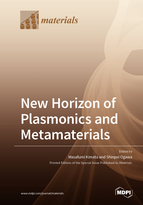New Horizon of Plasmonics and Metamaterials
A special issue of Materials (ISSN 1996-1944). This special issue belongs to the section "Materials Physics".
Deadline for manuscript submissions: closed (31 October 2019) | Viewed by 46115
Special Issue Editors
Interests: uncooled (thermal) infrared detectors; Type-II superlattice infrared detectors; infrared detectors; MEMS technology
Special Issues, Collections and Topics in MDPI journals
Interests: graphene; 2D materials; plasmonics; metamaterials
Special Issues, Collections and Topics in MDPI journals
Special Issue Information
Dear Colleagues,
Plasmonics and metamaterials are growing fields that consistently produce new technologies for controlling electromagnetic waves. Many important results in both fundamental science and applications are being addressed for a wide range of materials, structures, and wavelengths from the ultraviolet to the microwave. For instance, these fields have recently expanded to tackle research on graphene and other 2D materials, flat photonics, thermal control, and mechanical structures. Although remarkable progress is taking place across many different fields, the basis of this research shares many of the same underlying principles. Therefore, great synergy is expected among the scientists working in this wide spectrum of fields.
This Special Issue aims to introduce recent advances in plasmonics and metamaterials, as well as their applications, for a wide range of topics in order to explore the new horizon emerging for these fields. We hope that this Special Issue will inspire researchers to break new ground.
Prof. Dr. Masafumi Kimata
Dr. Shinpei Ogawa
Guest Editors
Manuscript Submission Information
Manuscripts should be submitted online at www.mdpi.com by registering and logging in to this website. Once you are registered, click here to go to the submission form. Manuscripts can be submitted until the deadline. All submissions that pass pre-check are peer-reviewed. Accepted papers will be published continuously in the journal (as soon as accepted) and will be listed together on the special issue website. Research articles, review articles as well as short communications are invited. For planned papers, a title and short abstract (about 100 words) can be sent to the Editorial Office for announcement on this website.
Submitted manuscripts should not have been published previously, nor be under consideration for publication elsewhere (except conference proceedings papers). All manuscripts are thoroughly refereed through a single-blind peer-review process. A guide for authors and other relevant information for submission of manuscripts is available on the Instructions for Authors page. Materials is an international peer-reviewed open access semimonthly journal published by MDPI.
Please visit the Instructions for Authors page before submitting a manuscript. The Article Processing Charge (APC) for publication in this open access journal is 2600 CHF (Swiss Francs). Submitted papers should be well formatted and use good English. Authors may use MDPI's English editing service prior to publication or during author revisions.
Keywords
- plasmonics
- metamaterials
- metasurfaces
- thermal control
- applications








